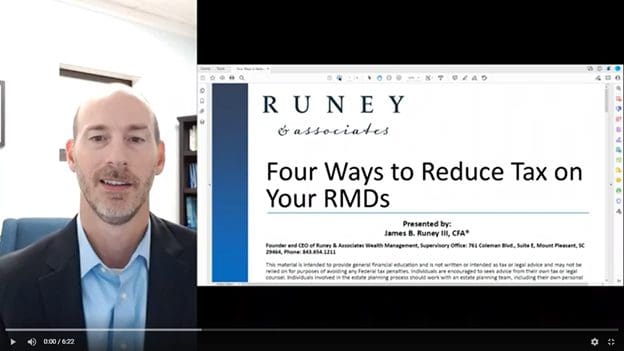As the end of the year approaches, we get many clients asking about Required Minimum Distributions (RMDs). Most people just assume that you must take your RMD, pay the tax, and there really is nothing you can do about it…But:
- Wouldn’t it be great if you could reduce those RMD amounts or simply pay less tax?
- Good news, here are four ways you can reduce taxes on RMDs.

In addition to the write up below we have also recorded a video of this post that you can watch. (If you want to view the video with subtitles, please make sure you click on CC once you are in YouTube to enable this setting.)
1. Qualified Charitable Distributions (QCDs):
QCDs are the best way to reduce taxes for those who give to charity, as most of us do anyway. Please see our full blog post on the details of QCDs for a refresher on how they work: Guide to Qualified Charitable Distributions in 2021
For purposes here, we will simply discuss how QCDs reduce your taxes. First of all, QCDs are only available to IRA owners or IRA beneficiaries who are age 70.5. Yes, that number is correct. You can do QCDs before the required distribution age of 72.
So, when you do a QCDs, instead of stroking a check to your favorite charity, you just transfer the amount you wish to donate directly from your IRA to the charity. When you do this, your distributions for your IRA are excluded from income, which is even better than a tax deduction, since you probably take the standard deduction nowadays anyways rather than itemizing.
If you use the QCD, you get to use the larger standard deduction, and you get to exclude the charitable distribution from income, which reduces your Adjusted Gross Income, which means you pay less income tax.
Here is the even better part. Your QCD counts towards your RMD, so if you wanted to use your entire RMD as a QCD you could, and it would significantly reduce your taxes for the year.
2. Qualifying Longevity Annuity Contracts (QLACs):
A QLAC is an annuity contract you can purchase with your IRA, and it gives you two major benefits.
One: since a QLAC allows you to transfer some of your IRA funds to purchase the annuity and because the QLAC is a deferred annuity, the distributions can be delayed until a future date. What this means for you is the amount that has been transferred to buy the QLAC doesn’t have any RMDs associated with it until the payout date.
The second major benefit starts when payments from the QLAC start, which is usually age 85. The contract provides income for life. The longer an individual lives, the longer a QLAC pays out, so you are protected from outliving your money, at least to the extent of the money you put into the QLAC from your IRA.
3. Systematic Partial Roth Conversions:
The third way to reduce taxes on your RMDs is my favorite, and one we use with many of our clients, which is systematic partial Roth conversions. If you have done well in building assets for retirement, then a big number on your statement may make you feel good. But remember, that big number is not all yours if it is in an IRA. Uncle Sam is eventually coming to take his slice.
If you have a large IRA, once you reach age 72, you may have a big tax problem because you are going to have to start taking the amount that is required, and that amount may push you into a higher tax bracket. If you have been a really good saver, it may even push you into a higher tax bracket than when you were working.
What you do is take enough money from your IRA to fill the lowest tax bracket each year, for the next 5 -10 years, and use that amount to convert to a Roth.
What this strategy will do for you is that although you will have to pay taxes on the conversions, you can make sure those taxes are nominal by keeping the amounts low as mentioned above, but the tradeoff is threefold:
- Much, much lower taxes in the future as the RMDs will be based on a lower overall IRA amount.
- The ability to take tax free withdrawals from the Roth bucket, which will lower your taxes even more.
- And finally, you will see significant growth in your wealth as the Roth bucket grows over the next several years until you start utilizing it for regular withdrawals.
4. Rollovers to Company Plans:
The fourth strategy to reduce taxes on RMDs, is a rollover to a company plan, and I am leaving this one for last because it only applies to that rare person who is still working come RMD age, which is 72.
If you are subject to RMDs from your IRA and also happen to still work at a company with a 401(k) plan, a rollover to the company plan may delay future RMDs. This strategy works because RMDs from a company plan are not required if you are still working there.
First, you must make sure the company plan allows roll-ins from IRAs. Also, before you can do a roll-in, you have to take the current year RMD, then the balance of your IRA can be rolled over to the company plan.
So, your RMD is eliminated as long as you are working. Now, when you retire, you will have to take that RMD, but perhaps, by then you are in a lower tax bracket, and you end up paying less.
We hope you found this breakdown helpful. If you have any questions or would like to explore these concepts further, please contact us. We would be happy to help.
By: Jamie Runey, Founder and CEO at Runey & Associates Wealth Management
